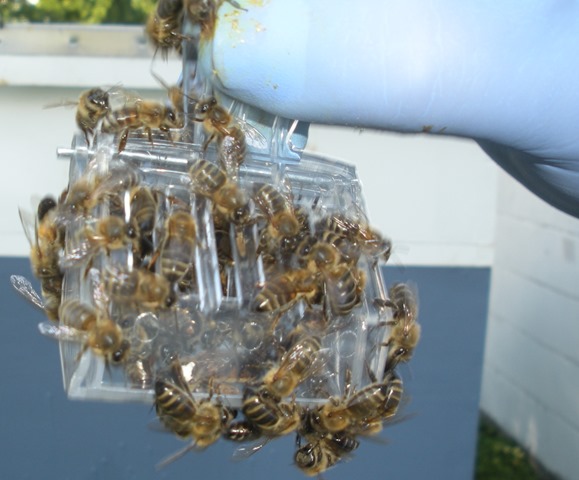Choose a specific date for the arrival of your new queen and communicate it to your queen breeder, ensuring that you receive a MARKED QUEEN. Ten days prior to the scheduled arrival of the new queen, place queen excluders between any two boxes where the old queen could reside. Upon the new queen’s arrival, provide her with water and store her in a cool, dark place until required. Assemble necessary equipment including a double screen board, an empty hive body, 10 drawn combs, and a feeder filled with a gallon of 1:1 sugar syrup.
Locate the existing queen within the colony to be requeened, typically identified in the brood box with larvae. Set her aside away from the colony to enable manipulation of the frames. Select three frames of brood – one capped and two with eggs and larvae – along with covering nurse bees, placing them in the center of the empty hive body. Complete the setup by adding six additional frames: two empty drawn combs (one on each side of the brood frames), two frames of pollen and honey (one on each side of the drawn comb), and two more empty drawn combs (one on each side of the honey-pollen frames), leaving space for the queen cage.
Transfer several frames of brood, remaining in the old colony, shaking the nurse bees into the new 9-frame nuc. Cover the nuc and set it aside temporarily. Return the frame with the old queen to her original hive and replace the removed frames (three of brood and two of honey-pollen) with empty drawn frames.
Place the double screen board on top of the old colony with its entrance facing the rear. Position the new 9-frame nuc on top and install the new queen (ensure the cork is removed from the candy end). Commence feeding the new nuc immediately. After 3-5 days, swiftly check the queen cage to ascertain if she has been released. If not, release her from the cage. Avoid disturbing the colony for another 5-7 days, then inspect for eggs and larvae with minimal smoke, adding the 10th frame and removing the queen cage if necessary.
Over the following 5-6 weeks, monitor the brood pattern of the new queen. If satisfied, eliminate the old queen located beneath the double screen and remove the double screen board.
This method offers several advantages: it provides a backup with the old queen if issues arise with the new queen, allows for requeening at a later date if necessary, and boosts hive strength for winter by having two queens laying eggs simultaneously. Note: If a Double Screen Board is unavailable, it’s recommended to acquire one for its benefits. If unfamiliar with its construction, envision a wooden queen excluder frame without metal wires, covered on both sides by 8 mesh wire – essentially, a DOUBLE SCREEN BOARD.
